Selfbuild






And much, much more including inspiration galleries, videos and podcasts, regular news updates and categorised advice sections




Europe’s leading, award-winning window brand for over 90 years. Innovative, high-performance architectural window and door systems for self-build, renovation and Passivhaus projects.
Outstanding quality, bespoke design, and exceptional thermal performance. For further information, please visit uk.internorm.com.
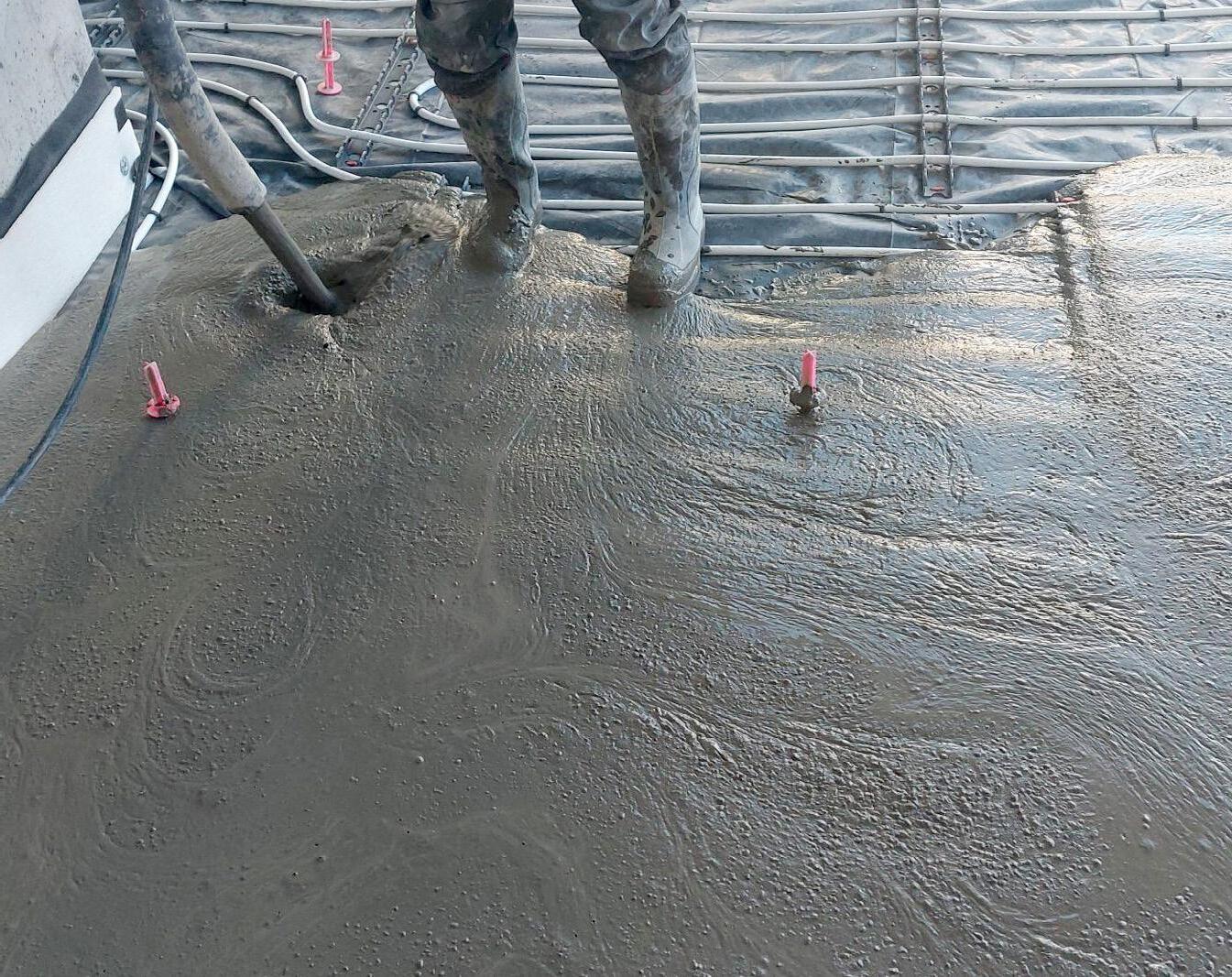
Roadstone FlowPlus is the next generation self-levelling cementitious screed developed in conjunction with the ARDEX Group.
Roadstone FlowPlus is the next generation self-levelling cementitious screed developed in conjunction with the ARDEX Group.
• Provides a quick, smooth and level surface with minimal leveling
• Ease and speed of installation
• Provides a quick, smooth and level surface with minimal leveling
• Suitable for all domestic and commercial applications
• Ease and speed of installation
• Suitable for all domestic and commercial applications


“What’s very clear is that self-builders really need all the help they can get at this point in time.”
Across the island of Ireland there are people, young and old, who are in the process of building their own home. Doing their research, getting their dream plans finalised. Pouring their blood, sweat and tears into their project, not to mention their life savings.
It’s a very rewarding journey to set out on and from the point of view of the housing crisis, a most commendable endeavour.
Yet, somehow, governments don’t seem that keen to help people build, be it in the countryside or not. After all, the ROI government’s plan to offer serviced sites in clusters hasn’t exactly panned out (page 12).
Some say the lack of enthusiasm is due to our rural landscape being a major feature of our tourism industry. In other words, dotting the countryside with one-off houses wouldn’t look the part. Others argue building out in the sticks encourages car use, at a time when we’re trying to reduce our dependence on fossil fuels.
But at the end of the day, don’t we need more homes to be built? They can’t all be apartments. There needs to be a mix of solutions. There’s no point complaining that there’s a rural exodus if we don’t allow people to build to live there.
What’s very clear is that selfbuilders really need all the help they

can get at this point in time.
Pre-Covid, homes we featured in the magazine were costing €250k to €350k, contractor led, now we’re looking at €400k homes. Sure, with house prices sky high it still makes sense to build, but economic uncertainty is putting many of us risk-averse folk off.
We have 2,600+ self-builders who’ve signed the petition to get rid of onerous development charges and water connection charges in ROI. We’re advocating for that waiver, which last year saved self-builders thousands and thousands of euros on their projects, to apply to self-builders only. There is no need to line the pockets of developers.
We’ve just sent a letter to the ROI government to reinstate the waiver on the back of the petition. Hopefully people power will prevail; we’ll keep you posted.

The second stage of being On Site deals with first and second fix. It will all move very fast at this stage, so preparation is key.
In the meantime, happy building!

Astrid Madsen - Editor astrid.madsen@selfbuild.ie

If you have a question, want to share some insights, or simply let us know how you’re getting on with your project, we’d love to hear from you for our Letters page. Email us at letters@selfbuild.ie

Front Cover Photograph: John Mee,
24 The test of time
Sarah and Paul Foster’s selfbuild in Co Meath shows what can be achieved with good design choices.
34 Framing the future
Ryan Daly chats about how his timber frame new build delivers on both energy efficiency and aesthetics.
46 A shore thing
How Michael and Tina Clancy transformed their coastal holiday home in Co Sligo into a sustainable, energy efficient, forever home.
56 Sydney vibes, Belfast style
All articles equally cover the 32 counties; when we refer to the Republic of Ireland the abbreviation is ROI. For Northern Ireland it’s NI.
Phil and Jennifer Baker’s Belfast home gets an Aussieinspired makeover, swapping a cold, disconnected sunroom for a bright, open extension that effortlessly blends indooroutdoor living.

64 Building a cosy home
Áine Carey’s direct labour new build in Co Donegal has the cosiness and character of a cottage that’s been lovingly restored.
70 Garden with levels
A Co Cavan garden design that deals with a sloped site and unsightly retaining walls.
74 Letters
Issues with upgrading the energy rating on an existing home, drying out the house, and how to flush €15k down the drain.
76 Is blockwork still the cheapest way to build?
Quantity surveyor Keith Kelliher looks at whether Ireland’s most popular building method is still the most cost effective.

78 Are roof windows a good idea?
Passive house consultant Seán McKenna weighs the benefits of incorporating roof windows into your design, and why you should steer clear of roof lights.
80 Throwing good money after bad
Eco builder Liam Walsh argues 40 per cent of grant-aided energy upgrades aren’t worth the money.
82 Savings room by room
Where to spend to save, plus some hacks to get the most bang for your buck on your new interiors.
84 Garage conversions
Engineer and architectural designer Les O’Donnell looks into how to transform your garage into a living space, and offers design ideas for granny flats.



88 Overview
An introduction to the second part of Stage 5 of your Selfbuild Journey: On site, dealing with first and second fix.
90 First fix
Watchpoints at the early stages of wiring and electrics.
96 Second fix
Watchpoints at the fit-out stage.
100
Watchpoints when it comes to finishing the external walls and putting up roof coverings.
Roof covering options, from traditional to more modern.
Liam Canavan chats through how he’s fitting out his timber frame extension, from installing the wall insulation himself, to tiling and drywalling.
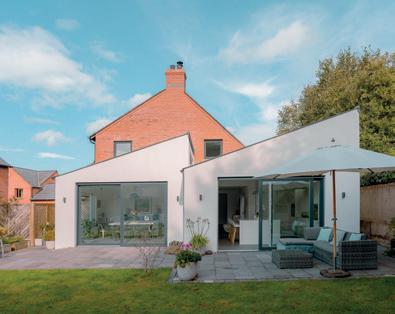
Gavin Connolly shares the secret ingredients that’ll have you breeze through the construction phase of your self-build, with tips and advice from his own experience with the trades and suppliers.
CONTACT info@selfbuild.ie
EDITOR
Astrid Madsen astrid.madsen@selfbuild.ie
DEPUTY EDITOR
Heather Campbell heather.campbell@selfbuild.ie
DESIGN
Myles McCann myles.mccann@selfbuild.ie
Shannon Quinn shannon.quinn@selfbuild.ie
Megan Buckley megan.buckley@selfbuild.ie
MARKETING
Calum Lennon calum.lennon@selfbuild.ie
Victoria Hunter victoria.hunter@selfbuild.ie
Rebecca Ferris rebecca.ferris@selfbuild.ie
Erin Mason erin.mason@selfbuild.ie
SUBSCRIPTIONS
Becca Haslett becca.haslett@selfbuild.ie
ADVERTISING SALES
Emma Phillips emma.phillips@selfbuild.ie
Joanna McConvey joanna.mcconvey@selfbuild.ie
Lisa Killen lisa.killen@selfbuild.ie
Maria Toland maria.toland@selfbuild.ie
Nicola Delacour-Dunne nicola.delacour@selfbuild.ie
ACCOUNTS
Karen McLeigh karen.mcleigh@selfbuild.ie
Leanne Rodgers leanne.rodgers@selfbuild.ie
SALES DIRECTOR

Mark Duffin mark.duffin@selfbuild.ie
MANAGING DIRECTOR
Brian Corry brian.corry@selfbuild.ie
CHAIRMAN Clive Corry clive.corry@selfbuild.ie
DISTRIBUTION
Delivering windows and doors that are crafted to last generations.
Redefining quality and luxury for almost a century. Our windows and doors are not just built to last, but crafted to inspire.
For more information visit nordan.ie
NorDan’s Timber/Alu-Clad Windows combine the classic warmth and beauty of timber on the inside with a tough weather-resistant aluminium cladding on the outside.
Merging timeless elegance and enduring strength, NorDan’s Timber/Alu-Clad Doors are perfect for those seeking stylish yet practical modern living solutions.
The ideal solution for modern homes and commercial properties, offering a huge range of design possibilities, enhanced energy efficiency, and premium performance.
The perfect solution for the contemporary needs of residential and commercial properties that highlight energy efficiency, low maintenance, and versatile design options.

NorDan’s Entrance Doors have been designed with durability and energy efficiency at the core. With contemporary and traditional designs available, there is a perfect match available for your perfect welcome home.


New ROI planning minister John Cummins is considering making it easier to build modular and cabin-style homes in back gardens without needing planning permission, to help tackle the housing crisis.
Right now, you can build extensions up to 40sqm connected to your main home without needing permission. But if you want to put up a detached structure, even if it’s the same size, it has to get approval. The new proposal would change that, allowing freestanding modular units to be built under the same 40sqm limit without the usual planning red tape.
The proposal will go through public consultation; there will also be a government evaluation how feasible these changes might be. As it stands, there’s no specific timeline for when we might see new regulations.
“I see it as the ability of people to be able to have that intergenerational movement within their own community and for younger people to live independently,” said
Minister of State Cummins.
“I’m not saying that this is a panacea, that it’s the solution to the housing crisis. I’m saying that this is a potential option that will suit certain circumstances,” he said.
If these changes go through, the exemptions would apply only to structures up to 40sqm. Anything bigger would still need full planning permission. The Minister of State added that it would be down to local authorities to look after regulations for the dwellings – despite not being subject to planning.
“It’s a matter for the local authorities, in the context of ensuring that things are compliant with planning and building standards. In the same way as if it…was attached to the main dwelling house,” he said.
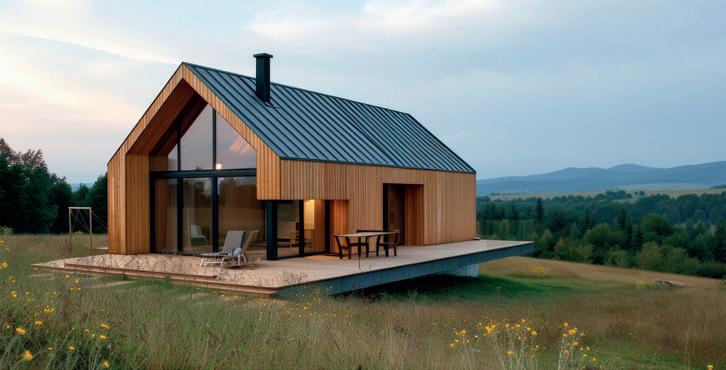
Self-builders in NI using the Planning Portal are facing higher costs. As of April 1, 2025 self-builders looking to secure outline planning permission had to pay £10 more, with fees increasing from £505 to £515. Reserved matters applications (following an outline approval, adding details like design) increased from £505 to £515 and a full planning application (detailed application for a single house) has increased from £1,014 to £1,035.
Planning applications for extensions, alterations or improvements to an existing house, new fences, walls, gates or outbuildings within a home’s boundary, increased from £340 to £347.
With a new ROI government in full swing, it seems grants and financing models that help more homeowners afford upgrades, particularly older people who may face financial or logistical barriers, are top of the agenda. Community-driven initiatives are also being supported, with group retrofitting schemes allowing neighbours to collaborate on upgrades and share costs.
Low-interest loans for energy improvements will remain available under the Home Energy Upgrade Loan Scheme, covering upgrades costing between €5,000 and €75,000. Measures to move older homes off oil-based heating systems are also being pushed, with sustainable biofuels promoted as a short-term alternative for homes unable to undergo immediate retrofits.
Grants for solar storage batteries could also be reintroduced; the government grants for batteries were axed in 2022.
Make the greener choice for your home, upgrade your existing central heating with an eco-friendly, low noise Midea Heat Pump. Air source heat pumps are the low-carbon future of home heating which integrates heating and domestic hot water into one system.
The future of heating, renewable energy is the greener, cleaner way to heat your home. Midea’s air source heat pumps are the costeffective way to lower your energy bills and switch to a low-carbon way of heating your home. Make yourself at home and start saving with Midea Heat Pumps.

OUR MIDEA MONOBLOC HEAT PUMP COMES WITH A MARKET LEADING 10 YEAR WARRANTY.


While Vacant
drawdowns have increased, the number of completed projects still falls short of government targets.
While the Vacant Property Refurbishment Grant (VPRG) has seen an increase in grant payments in 2024, a significant gap remains between the number of applications, approvals and actual drawdowns.
By the end of December 2024, over €77 million had been paid out for the refurbishment of 1,449 homes under the scheme. However, this figure is far below the government’s revised target of 4,000 homes by 2025.
Reflecting on the latest data, Minister for Housing James Browne said: “The rapid increase in grant payments shows the scheme is growing momentum, helping to tackle vacancy and providing much-needed housing.”
To date, Donegal County Council holds the highest number of applications (1,042), approvals (715) and grant payments (93). Cork County and Mayo County Councils had the second and third highest number of applications respectively.
The Vacant Property Refurbishment Grant scheme, introduced in 2022, aims
to revive vacant and derelict properties into permanent homes or rental units, with grants of up to €70,000 available upon completion of works. As of the end of 2024, over 11,300 applications had been received, and 7,700 approvals issued. But the number of drawdowns lags far behind the figures hoped for when the grant was first launched.
Critics point to one key obstacle in the programme: the requirement that homeowners fund the work upfront. Although 1,449 drawdowns were reported at the close of 2024, the scheme’s dependence on post-completion payments is a big hurdle for many homeowners, particularly those lacking the resources to cover refurbishment costs in advance.
That’s why Minister for Housing John Browne is considering stage payments for those availing of the grant, acknowledging that it’s difficult for families to avail of it as the grant has to be paid upfront. Mortgage providers must see that you can finance the entire cost of the work before starting.

According to the ROI Programme for Government, the vacant and derelict property refurbishment grants, worth up to €70k, will be extended to 2030. These grants, funded by the Croí Cónaithe (Towns) Fund, will undergo regular reviews.
The government has committed to ensuring every local authority has an expanded vacant property team in place to improve access to support. It will continue the Local Authority Home Loan bridging finance to support the use of the grants, and will roll out a new Local Authority Mortgage for vacant properties.
A new ‘Above the Shop’ Living Refurbishment Grant will be launched to convert vacant spaces above retail premises into residential use. Recognising the additional complexity involved in such projects, the scheme will provide extra funding, alongside pilot incentives like commercial rates reductions for property owners. The cost of infrastructure upgrades has also been flagged as a barrier to bringing derelict homes back into use. To tackle this, the programme includes a proposal to “credit existing water and wastewater connections” in the calculation of new connection charges.
In July 2024, in an attempt to help fill the funding gap, the government introduced the Local Authority Purchase and Renovation Scheme (LAPR), which applies to all properties eligible for VPRG.
Under the new LAPR, first-time buyers or Fresh Start applicants struggling to secure funding from commercial lenders can apply to their local authority for a LAPR to buy or renovate a VPRG eligible home. A key feature is the inclusion of a bridging loan. Tied to the VPRG this will boost applicants’ borrowing capacity and project viability. The bridging loan is repayable once the grant is paid out. This approach allows more funding for renovation works than typical bank loans.
The new ROI Programme for Government offers modest updates to existing schemes but falls short of providing the supports self-builders need.
The new Programme for Government takes a cautious approach towards helping selfbuilders and home improvers, focusing on protecting and expanding existing supports rather than introducing bold new initiatives.
While schemes such as Help to Buy, the First Home Scheme (FHS) and energy retrofit grants are set to continue with minor updates, the lack of substantial new measures is apparent.
Help to Buy will remain in place until 2030 and the FHS has been expanded to include first-time buyers of secondhand homes.
A major blow to self-builders
is the omission of any extension (or any reference at all) to the development levy waiver, which has been a key costsaving measure. Without this waiver, self-builders now face potentially thousands of euros in additional costs (see below). Instead, the new coalition government’s housing strategy centres on incremental improvements to existing schemes, such as streamlining grant processes, expanding refurbishment incentives and promoting energy efficiency. Proposals to cut VAT rates on building materials has also not been taken up by the new government.
The Local Authority Home Loan scheme, which is open to self-builders, will undergo significant changes, including the creation of a centralised administration point and adjustments to loan limits to reflect rising house prices. An expansion of the scheme to assist mortgage holders with non-bank lenders is also under consideration.
Addressing water infrastructure issues remains a key focus, with ongoing support for group water schemes and private well grants. Additionally, the rollout of the Special Rural Water Investment Scheme — also known as the
Unsewered Villages Scheme— aims to tackle long-standing issues in areas lacking adequate wastewater infrastructure.
Alongside these measures, the government is promoting Modern Methods of Construction (MMC) to speed up housing delivery and improve sustainability. A dedicated fund will support MMC but details are unclear. The initiative also includes a push for timber frame in new builds, as part of the government’s broader environmental goals.
Westport Councillor slams development levy’s impact on young couples in rural areas, calling for exemptions.
Independent Councillor John O’Malley has renewed his call to remove development levies for young couples building homes, stressing the financial strain on those trying to settle in rural areas.
Cllr O’Malley criticised the levy, describing it as a barrier to homeownership for local families.
“Building a house already costs at least €300,000 if you’re fortunate enough to have a site. Adding the development levy on top of that makes it nearly impossible for young couples to get started,” he said. “We should be encouraging families to settle in rural Ireland, not penalising
them with additional costs.”
Cllr O’Malley called for fairer solutions, such as exempting local first-time homebuilders from development levies while applying them to wealthy buyers or large-scale developments.
Self-builders currently have to pay Section 48 development levies to their local authority to pay for infrastructure costs such as roads. These can amount to tens of thousands of euros in certain areas.
According to analysis by Selfbuild, for a 200sqm house self-builders were paying on average €6,805 to their local authority for the Section 48 levy, ranging from €1,080 in Co
Monaghan to €30,301.50 in Dún Laoghaire-Rathdown County Council’s new Cherrywood development area.
In April 2023, the ROI cabinet introduced a temporary 12-month development holiday as one of several measures to stimulate house building. The waiver period was extended a number of times, with the final deadline for commencement of qualifying new builds set for December 31, 2024.
Self-builders who started construction before that deadline now have until December 31, 2026, to complete their projects. The scheme originally required the house to
be completed by the end of 2025.
The Business Post reports Minister Browne doesn’t intend to extend the waiver, as developers haven’t started on many of the projects that got the waiver.
Selfbuild has sent a letter to the minister outlining that 2,600+ self-builders have signed a petition to scrap the scheme for self-builders only.
Get updates and sign the petition here:

An exclusive selfbuild.ie survey reveals painfully slow progress on the government’s goal of 2,000 serviced sites by 2025, as only 30 sites have been made available and been identified as suitable for sale.
Just 21 fully serviced sites are currently available to selfbuilders looking to build their own homes in ROI through the government’s Ready to Build Scheme. To date, an additional nine sites have been sold.
Under the scheme, launched in 2022 under the Croí Cónaithe (Towns) fund, local authorities directly sell sites to self-builders at a discounted price and also provide services such as water, wastewater, electricity and access to the sites. All local authorities in Ireland are administering the scheme.
The government’s Ready to Build Scheme was designed to provide 2,000 serviced sites for self-builders in regional towns and villages by 2025.
The Programme for Government 2025 reaffirmed this goal, stating that each local authority would be required to deliver serviced sites for 3 to 10 housing units in at least three locations every year. Based on these projections, the initiative was expected to create between 279 and 930 serviced sites annually.
Yet, an informal nationwide survey of local authorities carried out by Selfbuild paints a bleak picture. Only nine out of the 31 councils responded when asked how many serviced sites they currently have available, with those who did respond reporting only a handful of sites in place.
Despite the ambitious targets, many councils are still in the early planning stages or struggling to secure land. Several local authorities have yet to make any serviced sites available under the scheme.
Clare, Kilkenny, Meath and Waterford confirmed they have not sold or made any serviced sites available. However, they are taking steps to progress the scheme forward, carrying out site feasibility studies.
Kildare County Council has seven sites in Clogherinkoe village, priced at €45,000 each.
Tipperary County Council has three fully serviced sites in Boherlahan village, available for €25,000 each.
Wicklow County Council has five sites in Kilcommon, priced between €35,000 and €50,000, but further expansion remains uncertain.
Laois County Council has been the most proactive, selling eight sites in 2024 and planning to release six more this year, while evaluating additional locations.
According to the Department of Housing, a further 140+ sites are at various stages of consideration by the relevant local authorities and the Department is “working with those local authorities to progress the sites”.
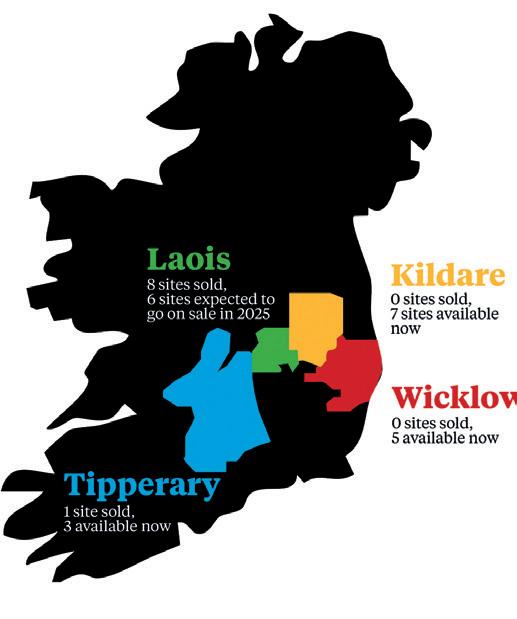
A key issue blocking progress is the lack of available land banks. Meath County Council, for instance, stated that the scheme remains in its early stages due to land shortages. Similarly, other counties are still reviewing potential sites but have yet to make concrete headway.
Housing Minister Browne told Selfbuild that the scheme still played a central part in the government’s “drive to
tackle vacancy and dereliction in towns and villages around the country”, stating: “my Department will continue to work with local authorities to progress suitable sites”. Adding: “By providing alternative choices for people to live in our towns and villages we are supporting the growth and development of these places – strengthening Ireland’s rural urban fabric, and supporting the communities who live there.”
Whether you are upgrading an existing property or building new, the addition of an insulated thermal lining to the inside of a wall, roof slope or ceiling will dramatically improve the energy efficiency standards in your home.
Why choose Unilin Thermal Liners?
Optimum performance from a thinner board
Cost-effective
External wall appearance maintained
Easy to install
Readily available from your local builders merchant
For expert advice, contact our technical team on 046 906 6050 or discover the range below:


The Conservation Advice Grant for vacant traditional farmhouses has been cut by a third, as scheme exits pilot stage and gets rolled out.
If you own a vacant, traditional house then you may qualify for the Conservation Advice Grant launched by the ROI government in March – but you’ll be getting €5,000 or €2,500 less than the original pilot scheme grant amount offered in 2023.
Now in its second year, the Conservation Advice Grant Scheme for Vacant Traditional Farmhouses will provide grants of up to €5,000 (excluding VAT) to cover the cost of having a conservation expert with the right experience to conduct a survey and put together a tailored conservation advice for the property owner. The original maximum grant offered by the pilot scheme was €7,500.
The scheme is aimed at homeowners applying for or considering the Vacant Property Refurbishment Grant, which provides funding of up to €50,000 for vacant properties and up to €70,000 for derelict homes. The conservation grant covers up to 67 per cent of costs for expert advice on repairs, improvements and energy efficiency measures for traditional buildings.
This includes a report outlining the condition of the building and identifying repairs and improvements that would restore it to use while enhancing its

character, energy efficiency, integrity and amenity.
By partially offsetting the cost of engaging expert advice at an early stage, the scheme also helps owners to avoid the risk of damage to their properties, obtain the services of appropriately skilled tradespeople and ensure value for money in the completion of their projects.
For more about who qualifies and how to apply here


Climate rules ending boiler replacement grants in ROI from the beginning of January 2025 leave vulnerable homeowners facing high costs and winter hardships in poorly insulated homes.
The change is driven by the Energy Performance of Buildings Directive (EPBD), adopted in May 2024, which prohibits public funding for new fossil fuel boilers from January 1, 2025.
However, grants for repairing existing fossil fuel boilers remain unaffected. The directive is part of the EU’s efforts to improve energy performance and reduce emissions, but its rigid application has drawn criticism for disproportionately impacting Ireland’s elderly population.
The Department of Housing defends the measure, stating that the EU directive aims to prevent vulnerable households from being “locked into” fossil fuel systems. However, critics argue that the policy undermines the principle of a “just transition”, placing the burden of climate action on those least equipped to shoulder it.
The directive does not prohibit grant funding for renewable heating systems. Homeowners are being encouraged to explore options such as heat pumps, solar energy and hybrid systems. The Sustainable Energy Authority of Ireland (SEAI) offers grants for these systems, including free grants (fully funded work) for those on certain welfare payments, including those on job seekers allowance, under the Warmer Homes Scheme.
With updated fire safety regulations set to take effect in NI on May 6, 2025, here’s what you need to be aware of at the design and build stages.
The latest update to the Building (Amendment) Regulations (Northern Ireland) 2024 introduces several important fire safety measures under Technical Booklet E –Fire Safety. While most apply to multi-dwelling or high-rise buildings, some will affect selfbuilds.
These changes are about improving fire detection and making it easier for fire services to access your home in the event of a fire. Here’s what you need to know to stay ahead of the curve.
A key change is that smoke alarms must now be installed in every single room, an increase from the old rule that only required them in the main living room, circulation spaces and kitchens. The technical booklet wording is: “an automatic fire detection and fire alarm system complying with BS 5839-6 of at least D2 Category LD2 standard including a smoke alarm or
alarms in every habitable room and a heat alarm or alarms in every kitchen”.
Under the previous rules, the fire service had to reach the front door with a hose, within 45 metres of the fire engine. The new regs, however, stipulate that they need to be able to reach every part of your home within that same 45-metre distance from the fire engine. This change could affect the
layout and design of your home, particularly if you’re in a rural or remote area. These changes are designed to improve the safety and accessibility of new build homes, making sure that both the occupants and emergency responders are better protected.
More information on Department of Finance’s website, finance-ni.gov.uk
Get expert architectural advice and support a great cause at the same time.
If you’re planning a new build or renovation, you probably have plenty of questions and may not know where to start. The good news? Two great initiatives allow you to get expert guidance from a registered architect while making a meaningful difference. By making a donation to charity, you’ll receive a onehour consultation with an experienced architect who can help you refine your ideas and plans.
It’s important to note that all participating architects volunteer their time and expertise, ensuring that 100 per cent of donations go to charity. This is a fantastic opportunity to receive expert advice tailored to your project while supporting a cause that changes lives.
In ROI: The RIAI Simon Open Door initiative, which opened on March 10th 2025, sees you make a donation of €125 to Simon Communities, and book an hour-long consultation with a Royal Institute of the Architects of Ireland (RIAI) registered architect.
Simon Communities provide housing and vital services for people experiencing homelessness across Ireland.
Your donation supports this important work while giving you access to expert architectural advice on building, renovating, or retrofitting your home.
Consultations will be held between April 7–13, book you spot at: riaisimonopendoor.ie.
In NI: Ask an Architect

is back this spring, offering homeowners in Northern Ireland a chance to meet with a registered architect. For a minimum donation to Friends of the Cancer Centre at Belfast City Hospital, you’ll receive a one-hour consultation with an architect registered with the Royal Society of Ulster Architects (RSUA).
Friends of the Cancer Centre
is one of Northern Ireland’s leading cancer charities, focusing on clinical care, patient comfort, and cancer research. Every penny raised through Ask an Architect goes directly to supporting local cancer research.
Book your consultation at askanarchitect-ni.com.

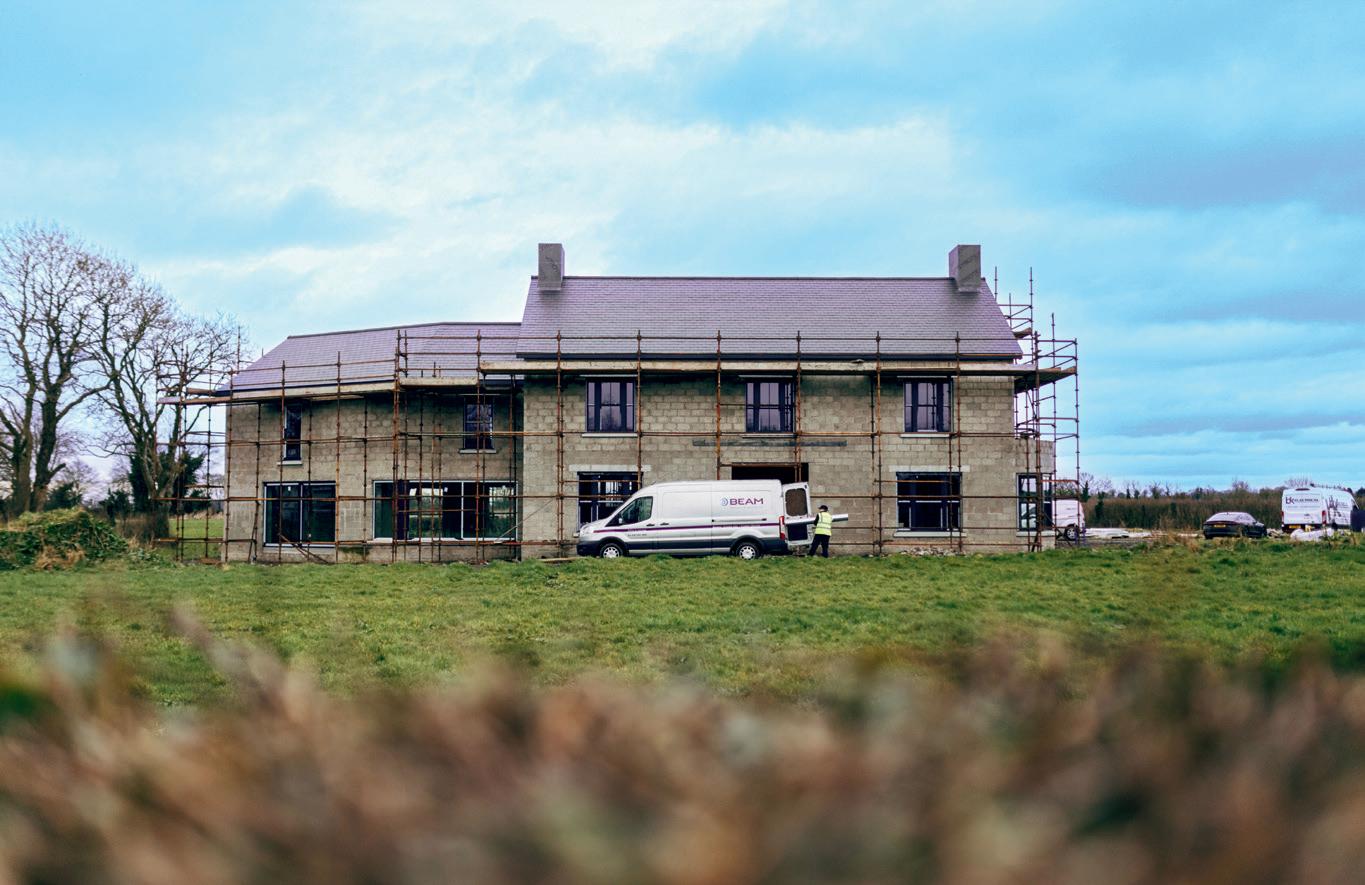







The Federation of Master Builders Awards 2025 are all about clebrating quality of workmanship. Here, we’ve got a treat in store… the Sustainability Building Award entries for Northern Ireland. Enjoy!
The Federation of Master Builders (FMB) Master Builder Awards are the pinnacle of recognition for small to medium-sized building firms across the UK, a celebration of exceptional craftsmanship, client satisfaction and building excellence. Recognised as the gold standard in the industry, these awards champion the very best in construction, from sustainability and innovation to heritage restoration and customer care.
On 23 May 2025, Northern Ireland’s most skilled builders will gather at The Malone Hotel, Belfast to honour the regional winners, each of whom will then go on to represent Northern Ireland at the UKwide finals in September. Finalists have a chance to win a brand-new Isuzu Pick-Up Truck worth £42,000, courtesy of headline sponsor Isuzu, as well as national exposure.
For builders, the awards are not only a mark of professional pride but a platform for future growth, showing clients they uphold the highest standards. For homeowners, they’re a reminder that when you choose an FMB Master Builder, you’re choosing quality, accountability and proven expertise.
More information on fmb.org.uk
Set high above Strangford Lough, this once energyinefficient 200-year-old cottage has been transformed into an EPC (Energy Performance Certificate) A-rated eco home. Despite recommendations to demolish the property, the clients chose a full retrofit, preserving the home’s character and embedded
carbon while dramatically improving sustainability and comfort. The property was modestly extended and reimagined with help from McAdam Stewart Architects and Daly Renewables.
Environmental upgrades included external wall insulation by Soltherm EWI, triple glazing, 600mm loft insulation, mechanical ventilation with heat recovery (MVHR) system, an air source heat pump and photovoltaic (PV) panels on the new garage. Locally sourced materials and trades helped reduce
carbon emissions, while careful logistics planning and waste minimisation protected the surrounding Area of Outstanding Natural Beauty. The result is a modernised, all-electric home with dramatically lower bills (under £800/year) and a deep respect for its historic footprint. The project reflects both the builder’s technical skill and the client’s values, achieving sustainable, low-impact living without compromise.
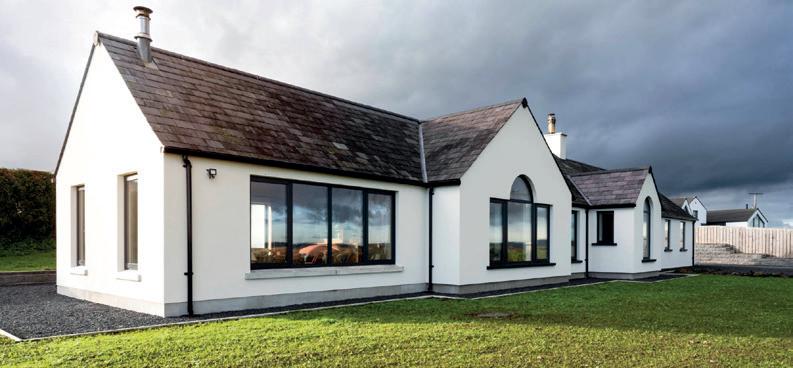

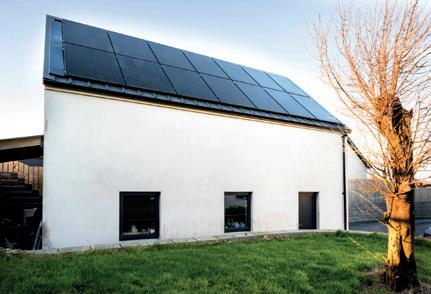
Set high on the North Antrim coast, this two-storey timberframe holiday home is a blueprint for all-electric, low-carbon living. Designed in collaboration with John Kennedy Architects, the house was built to operate entirely on renewable energy, combining a smart integration of PV, battery storage, and intelligent energy tech to dramatically cut emissions and reduce dependence on the grid.
Built using airtight construction, high levels of insulation, and triple glazing, the home also features a
Built on a brownfield site with panoramic coastal views, this bespoke detached family home in Greenisland blends cutting-edge energy technology with modern,
ventilation and heating Nilan air system with Helios backup. The Electric Storage Company’s PARIS Greentech system allows the home to learn usage patterns and optimise energy flow-storing, using, or even selling excess electricity.
This was Setanta’s first fully electric new build, requiring complex modelling and close collaboration with stakeholders. Despite site access challenges, the team delivered a highly efficient home that meets Passivhaus principles, futureproofed for technological advances and backed by a strong clientbuilder partnership.
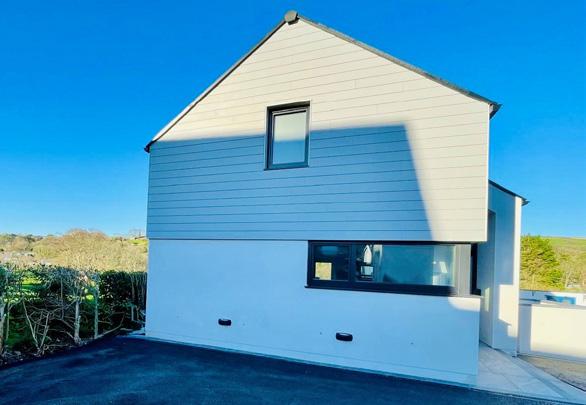

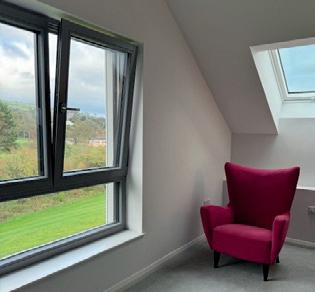
elegant design. Designed with saleability in mind, the property was sold off-plan early in the build and completed in collaboration with its new owners, who moved from Germany to Northern Ireland. The home achieves a Standards Assessment Procedure or SAP of 102, meaning it generates more energy than it consumes.
Sustainability features include an air source heat

pump, PV system, battery storage, underfloor heating and an MVHR system, all controlled via an intelligent eco-smart management system. The build also prioritised airtightness, local materials and upskilling the site team to roll out lowenergy principles across future projects.
Thoughtful touches like retaining native hedgerows for biodiversity, introducing

a user welcome pack and providing personalised support throughout the project reflect a commitment not just to performance, but to people. This project sets a new benchmark for combining luxury and low-carbon living in Northern Ireland.
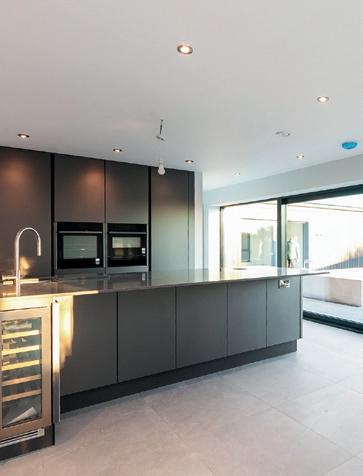
Perched on a 1.2-acre woodland plot with sweeping views of Belfast Lough, this 5,100sqft Georgian-style family home combines period aesthetics with cutting-edge sustainability. Delivered by Distinguished Homes
in collaboration with the developer and architect, the project features timber frame construction, handmade clay brick, sash windows and premium finishes, all designed with energy efficiency and environmental sensitivity at its core.
The property includes a 50kW battery, 20 solar PV panels, air source heat pump, underfloor heating across three levels and a smart home system to monitor energy
performance. Built on a former derelict site (containing asbestos and bats), the team took a conservation-first approach, working with ecologists and recycling all site materials, including repurposed rubble, wood chippings and rainwater harvesting. Despite 177 tree preservation orders, all removed trees were replanted, with deadwood repurposed for wildlife habitats.
With the buyers living in Los
Angeles throughout the build, Distinguished Homes managed the project seamlessly through remote Zoom meetings, detailed updates and collaborative selections. The result is a home that achieved a SAP of 94, was delivered on time and on budget, and demonstrates what’s possible when craftsmanship meets climate consciousness.



GP McManus
This Grade B1 listed Georgian property underwent a meticulous restoration and renovation, returning a near 200-year-old home to its original grandeur. Led by GP McManus in collaboration with Taylor and Boyd structural engineers, the project involved complex structural work, including the replacement of the entire roof, extensive dry rot treatment, and the preservation of historic features like original trusses, cornicing, stained glass and sash windows.
Key challenges included maintaining full waterproofing during the roof removal to protect ornate interiors and navigating countless design changes while adhering to strict heritage guidelines. All work was documented and reinstated like-for-like, from parapets and battlements to intricate ceiling mouldings, with care taken to photograph and preserve details throughout.
The team also improved the building’s energy performance using Isover’s Optima insulation system, specially suited to heritage properties. Regular site meetings, clear stakeholder communication, and a passionate client-builder relationship helped ensure the project was delivered to a high standard, on time and within budget.





Build your dream energy-efficient home with CavityTherm, the ultimate insulation for cavity walls. Perfect for self-builders, CavityTherm delivers passivhaus-level U-values as low as 0.12 W/ m²K, ensuring top-tier energy efficiency and thermal performance.
Outstanding U-Values: Achieve passive-level insulation in cavities under 150mm wide.
Smart Design: Engineered edge joints, easy-to-use accessories, and detailed guides for smooth installation and Part L compliance.
Moisture Control: Unique HIPS facing directs moisture safely away from your home’s structure.
Eco-Friendly: Sustainable PIR insulation designed to reduce carbon impact.
Trusted across Ireland and the UK for both new builds and renovations, CavityTherm is the reliable, high-performance solution for self-builders seeking easy installation, superior insulation, and building code compliance.
Take the next step toward your energy efficient home with CavityTherm. For expert advice and technical support, contact SIG today!






Belfast: +44 28 9038 0060
Omagh: +44 28 8224 6220
Dublin: +353 1 623 4541
Limerick: +353 61 531 381
Cork: +353 21 432 1868
enquiries@sig.ie
www.sig.ie

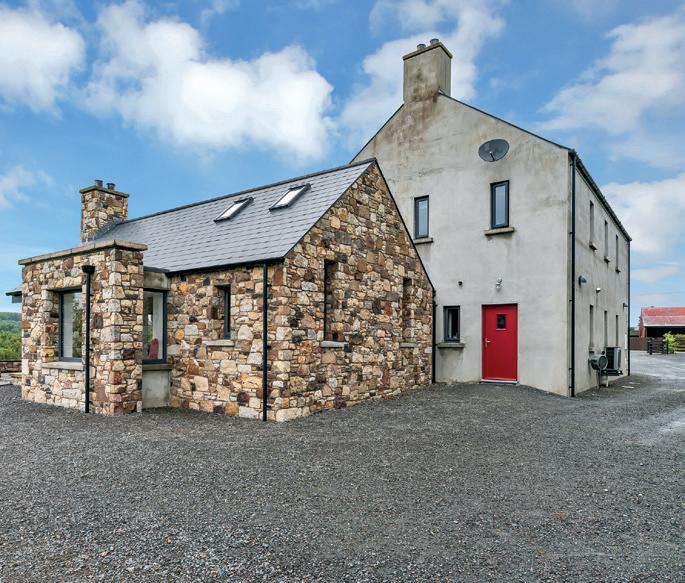

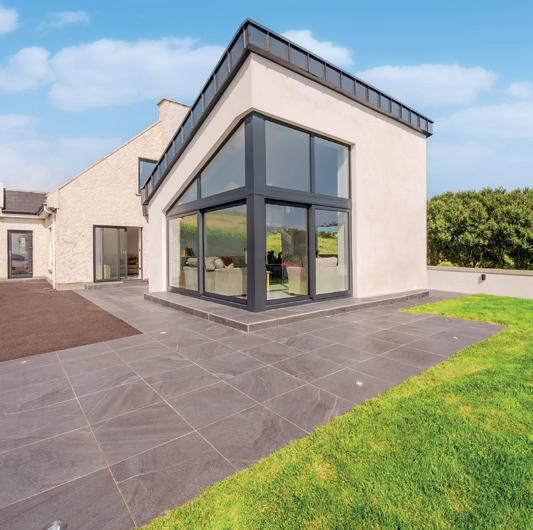


House size: 230sqm (270sqm including attic)
Bedrooms: 4
Heating system: Air to water heat pump and under floor heating
Ventilation: Centralised mechanical ventilation with heat recovery
Build method: Block BER: A3

Completed nearly seven years ago, Sarah and Paul Foster’s self-build in Co Meath shows what can be achieved with good design choices and tender loving care.